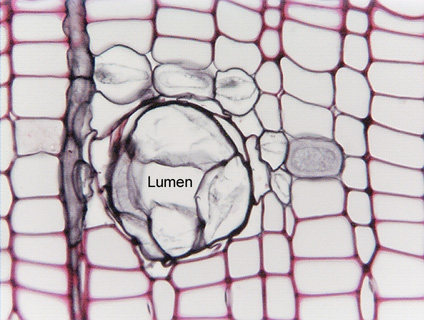 Fig. 3.2-7. Transverse
section of pine wood (Pinus). This is one of the secretory
ducts in pine that produce the pitch that you may have seen oozing
from a wound in a living tree or dripping from a piece of pine lumber. Although
these are secretory parenchyma cells, they do not have dense protoplasm like
that of ducts in Artemisia (Fig. 3.2-6). These parenchyma cells are
rather large and pillowy, and the walls that faces the duct lumen are not smooth
and taut but instead are undulate, so they do not show a clean profile. The
outer walls of each cell are somewhat thicker than is typical of parenchyma
cells.
Fig. 3.2-7. Transverse
section of pine wood (Pinus). This is one of the secretory
ducts in pine that produce the pitch that you may have seen oozing
from a wound in a living tree or dripping from a piece of pine lumber. Although
these are secretory parenchyma cells, they do not have dense protoplasm like
that of ducts in Artemisia (Fig. 3.2-6). These parenchyma cells are
rather large and pillowy, and the walls that faces the duct lumen are not smooth
and taut but instead are undulate, so they do not show a clean profile. The
outer walls of each cell are somewhat thicker than is typical of parenchyma
cells.